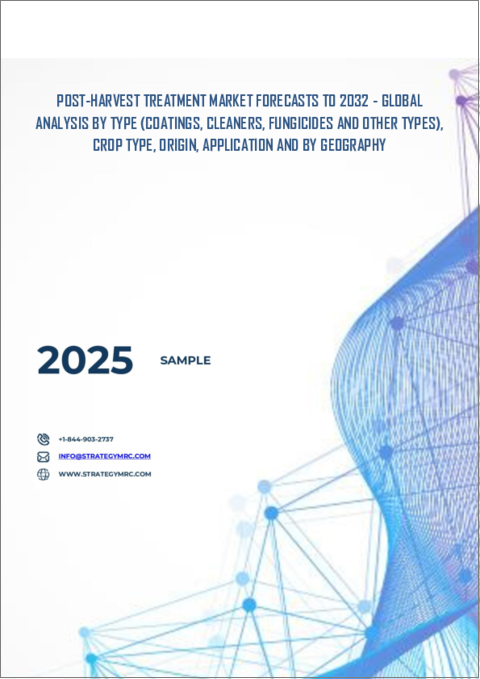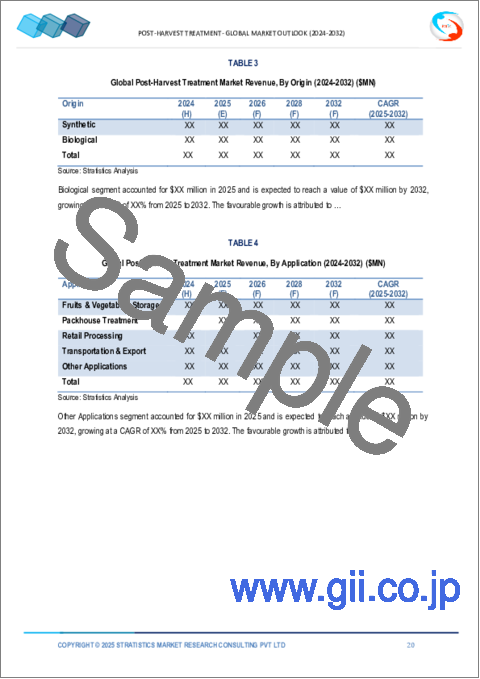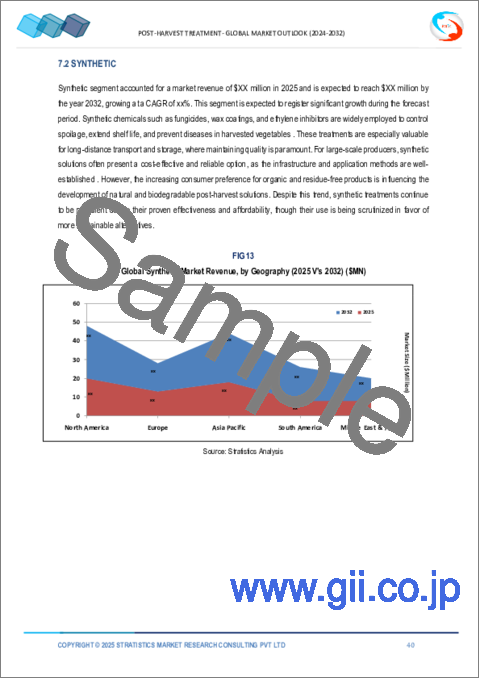|
|
市場調査レポート
商品コード
1700136
ポストハーベスト処理市場の2032年までの予測:タイプ別、作物タイプ別、原産地別、用途別、地域別の世界分析Post-Harvest Treatment Market Forecasts to 2032 - Global Analysis By Type (Coatings, Cleaners, Fungicides and Other Types), Crop Type, Origin, Application and By Geography |
||||||
カスタマイズ可能
|
|||||||
| ポストハーベスト処理市場の2032年までの予測:タイプ別、作物タイプ別、原産地別、用途別、地域別の世界分析 |
|
出版日: 2025年04月03日
発行: Stratistics Market Research Consulting
ページ情報: 英文 200+ Pages
納期: 2~3営業日
|
全表示
- 概要
- 図表
- 目次
Stratistics MRCによると、世界のポストハーベスト処理市場は2025年に24億米ドルを占め、予測期間中にCAGR 9.3%で成長し、2032年には44億7,000万米ドルに達する見込みです。
ポストハーベスト処理」とは、収穫後の農産物の品質保持、保存可能期間の延長、ロスの低減のために農産物に施される様々な処理を指します。洗浄、選別、等級付け、乾燥、冷却、および熟成剤、ワックスコーティング、殺菌剤などの化学的塗布は、こうした処理の一部です。さらに、低温貯蔵、管理された環境下での包装、放射線照射などの方法が、鮮度の維持と腐敗の防止に役立ちます。食品の安全性を維持し、市場性を向上させ、製品を可能な限り最高の状態で顧客に届けるには、すべて効率的なポストハーベスト手順にかかっています。
高まる有機農業と持続可能な農業の動向
有機栽培の果物は腐敗しやすいため、自然で環境に優しいポストハーベストソリューションがますます求められています。品質を保持し、保存期間を延ばすために、生分解性コーティング剤、バイオベースの殺菌剤、環境に優しい貯蔵オプションが人気を集めています。食品廃棄を減らし、厳しい有機認証要件を満たすため、農家や食品供給業者は最先端のポストハーベスト技術に投資しています。さらに、生産者は、新鮮で化学物質を含まない製品を求める顧客の嗜好により、より安全な処理オプションを作り出すよう迫られています。
最先端のポストハーベスト技術の高コスト
自動選別、包装、低温貯蔵システムなどの高価な機器には、多額の初期投資が必要です。経済的制約のため、多くの農家や農業関連企業は、品質を低下させ賞味期限を短くする時代遅れの慣行に頼っています。さらに、運営費や維持費がかさむため、普及が妨げられています。利害関係者は、補助金や限られた資金援助の不足により、現代的な解決策を得ることが困難であると感じています。その結果、市場の拡大が鈍化すると、効率向上とポストハーベストロス減少の恩恵は限定的なものになります。
天然およびバイオベースの処理に対する需要の高まり
顧客は、化学薬品を使用せず有機栽培された製品を好むため、農家は環境に有益な慣行を使用するようになります。バイオベースの処理は、保存性を高め、残留化学物質を減らし、食品の安全性を向上させることに成功しています。天然代替物への移行は、合成化学物質の厳格な制限によってさらに助長されています。微生物溶液、エッセンシャルオイル、生物学的コーティングの進歩の結果、市場の見通しは拡大しており、持続可能性への関心が高まるにつれ、バイオベースのポストハーベスト処理の使用は増加しています。
従来の貯蔵・処理方法との競合
特に発展途上国では、農家が露天乾燥や簡易貯蔵といった伝統的な方法を広く使用しているため、高度な処理の必要性は低下しています。伝統的な方法は資本を必要としないことが多いため、小規模な製造業者にとってはより手頃な価格です。現代のポストハーベスト対策の採用も、無知と変化への消極性によって遅れています。伝統的な貯蔵方法には確立された供給ルートがあるため、新技術は参入障壁に直面します。その結果、広く受け入れられることが、ポストハーベスト処理市場の拡大にとって大きな障害となっています。
COVID-19の影響
COVID-19パンデミックは、サプライチェーンの混乱、労働力不足、輸送制限によりポストハーベスト処理市場を混乱させました。ロックダウンにより原材料の入手が妨げられ、製品の納入が遅れ、処理プロセスに影響が出ました。外食産業からの需要減退は売上に影響を与えたが、生鮮食品と包装食品に対する消費者の嗜好の高まりが市場の回復を促しました。スマートストレージや生物学的処理など、ポストハーベスト技術の革新が牽引役となりました。経済が再開して農業活動が正常化し、食糧安全保障と持続可能性が確保されるにつれて、市場は徐々に回復しました。
予測期間中、除菌剤分野が最大となる見込み
除菌剤セグメントは、食品の安全性を確保し、農産物の保存期間を延長することで、予測期間中に最大の市場シェアを占めると予想されます。微生物汚染に対する懸念の高まりと厳しい食品安全規制が、効果的な除菌ソリューションへの需要を煽っています。オーガニックで環境に優しい除菌剤の採用が増加していることも、市場の成長をさらに加速させています。ポストハーベストサニテーションの技術的進歩は効率を高め、ポストハーベストロスを削減します。食品衛生に対する消費者の意識の高まりは、市場における除菌剤の役割を強化します。
パックハウス処理分野は予測期間中に最も高いCAGRが見込まれます。
予測期間中、流通前の農産物の品質と寿命のため、パックハウス処理分野が最も高い成長率を示すと予測されます。これには洗浄やコーティングなどのプロセスが含まれ、保存性を高め、ポストハーベストロスを減少させる。自動選別や化学処理などの先進技術は、効率と世界の食品安全基準への準拠を向上させる。新鮮で輸出品質の農産物に対する需要の高まりが、パックハウス処理の必要性をさらに高めています。食品の品質に対する消費者の意識が高まるにつれ、パックハウスソリューションはサプライチェーンの完全性を維持し、廃棄物を最小限に抑える上で重要な役割を果たします。
最大のシェアを占める地域:
予測期間中、農業生産の増加と食品ロスを減らす必要性から、アジア太平洋地域が最大の市場シェアを占めると予想されます。中国、インド、日本のような国々は、コーティング、燻蒸剤、生物学的処理を含む高度なポストハーベスト技術に投資しています。新鮮で高品質な農産物に対する消費者の需要の高まりが、革新的な保存方法の採用を後押ししています。冷蔵倉庫や物流インフラに対する政府の取り組みや補助金が、市場拡大をさらに後押ししています。大手農業関連企業や技術プロバイダーの存在が、この地域のポストハーベスト管理能力を高めています。
CAGRが最も高い地域:
予測期間中、北米地域が最も高いCAGRを示すと予想されるが、これは新鮮で高品質の農産物に対する需要の増加によるものです。食品廃棄に対する意識の高まりと保存期間を長くする必要性が、高度なポストハーベストソリューションの採用を促進しています。この市場は、鮮度を維持するためのコーティング剤、殺菌剤、バイオベースの保存料における技術革新によって活性化されています。米国がこの地域を支配しており、カナダも農業保存技術を拡大しています。厳しい食品安全規制と持続可能性の動向が業界の進化をさらに形成しています。
無料カスタマイズサービス:
本レポートをご購読のお客様には、以下の無料カスタマイズオプションのいずれかをご利用いただけます:
- 企業プロファイル
- 追加市場企業の包括的プロファイリング(3社まで)
- 主要企業のSWOT分析(3社まで)
- 地域セグメンテーション
- 顧客の関心に応じた主要国の市場推計・予測・CAGR(注:フィージビリティチェックによる)
- 競合ベンチマーキング
- 製品ポートフォリオ、地理的プレゼンス、戦略的提携に基づく主要企業のベンチマーキング
目次
第1章 エグゼクティブサマリー
第2章 序文
- 概要
- ステークホルダー
- 調査範囲
- 調査手法
- データマイニング
- データ分析
- データ検証
- 調査アプローチ
- 調査資料
- 1次調査資料
- 2次調査情報源
- 前提条件
第3章 市場動向分析
- 促進要因
- 抑制要因
- 機会
- 脅威
- 用途分析
- 新興市場
- COVID-19の影響
第4章 ポーターのファイブフォース分析
- 供給企業の交渉力
- 買い手の交渉力
- 代替品の脅威
- 新規参入業者の脅威
- 競争企業間の敵対関係
第5章 世界のポストハーベスト処理市場:タイプ別
- コーティング
- 食用コーティング
- ワックスコーティング
- クリーナー
- 塩素系
- 過酸化水素
- 過酢酸
- 殺菌剤
- エチレンブロッカー
- 発芽抑制剤
- 消毒剤
- 消毒剤
- その他のタイプ
第6章 世界のポストハーベスト処理市場:作物タイプ別
- 果物
- 柑橘類
- ナシ果実
- トロピカルフルーツ
- 核果
- ベリー
- 野菜
- 葉物野菜
- 根菜類
- 花と観葉植物
- 穀物
- その他の作物タイプ
第7章 世界のポストハーベスト処理市場:原産地別
- 合成
- 生物学的
第8章 世界のポストハーベスト処理市場:用途別
- 果物と野菜の保管
- パックハウス処理
- 小売加工
- 輸送と輸出
- その他の用途
第9章 世界のポストハーベスト処理市場:地域別
- 北米
- 米国
- カナダ
- メキシコ
- 欧州
- ドイツ
- 英国
- イタリア
- フランス
- スペイン
- その他欧州
- アジア太平洋
- 日本
- 中国
- インド
- オーストラリア
- ニュージーランド
- 韓国
- その他アジア太平洋地域
- 南米
- アルゼンチン
- ブラジル
- チリ
- その他南米
- 中東・アフリカ
- サウジアラビア
- アラブ首長国連邦
- カタール
- 南アフリカ
- その他中東とアフリカ
第10章 主な発展
- 契約、パートナーシップ、コラボレーション、ジョイントベンチャー
- 買収と合併
- 新製品発売
- 事業拡大
- その他の主要戦略
第11章 企業プロファイリング
- Pace International
- DECCO-UPL
- JBT Corporation
- Syngenta
- DowDupont
- Xeda International
- Colin Campbell Chemicals Pty Ltd
- AgroFresh
- FMC Corporation
- Nufarm
- Bayer
- Fomesa Fruitech
- Janssen Pharmaceutica NV
- Futureco Bioscience S.A.
- Post-Harvest Solution Ltd
- Citrosol
- Corteva Agriscience
- Apeel Sciences
List of Tables
- Table 1 Global Post-Harvest Treatment Market Outlook, By Region (2024-2032) ($MN)
- Table 2 Global Post-Harvest Treatment Market Outlook, By Type (2024-2032) ($MN)
- Table 3 Global Post-Harvest Treatment Market Outlook, By Coatings (2024-2032) ($MN)
- Table 4 Global Post-Harvest Treatment Market Outlook, By Cleaners (2024-2032) ($MN)
- Table 5 Global Post-Harvest Treatment Market Outlook, By Edible Coatings (2024-2032) ($MN)
- Table 6 Global Post-Harvest Treatment Market Outlook, By Wax Coatings (2024-2032) ($MN)
- Table 7 Global Post-Harvest Treatment Market Outlook, By Chlorine-based (2024-2032) ($MN)
- Table 8 Global Post-Harvest Treatment Market Outlook, By Hydrogen Peroxide (2024-2032) ($MN)
- Table 9 Global Post-Harvest Treatment Market Outlook, By Peracetic Acid (2024-2032) ($MN)
- Table 10 Global Post-Harvest Treatment Market Outlook, By Fungicides (2024-2032) ($MN)
- Table 11 Global Post-Harvest Treatment Market Outlook, By Ethylene Blockers (2024-2032) ($MN)
- Table 12 Global Post-Harvest Treatment Market Outlook, By Sprout Inhibitors (2024-2032) ($MN)
- Table 13 Global Post-Harvest Treatment Market Outlook, By Sanitizers (2024-2032) ($MN)
- Table 14 Global Post-Harvest Treatment Market Outlook, By Disinfectants (2024-2032) ($MN)
- Table 15 Global Post-Harvest Treatment Market Outlook, By Other Types (2024-2032) ($MN)
- Table 16 Global Post-Harvest Treatment Market Outlook, By Crop Type (2024-2032) ($MN)
- Table 17 Global Post-Harvest Treatment Market Outlook, By Fruits (2024-2032) ($MN)
- Table 18 Global Post-Harvest Treatment Market Outlook, By Citrus Fruits (2024-2032) ($MN)
- Table 19 Global Post-Harvest Treatment Market Outlook, By Pome Fruits (2024-2032) ($MN)
- Table 20 Global Post-Harvest Treatment Market Outlook, By Tropical Fruits (2024-2032) ($MN)
- Table 21 Global Post-Harvest Treatment Market Outlook, By Stone Fruits (2024-2032) ($MN)
- Table 22 Global Post-Harvest Treatment Market Outlook, By Berries (2024-2032) ($MN)
- Table 23 Global Post-Harvest Treatment Market Outlook, By Vegetables (2024-2032) ($MN)
- Table 24 Global Post-Harvest Treatment Market Outlook, By Leafy Greens (2024-2032) ($MN)
- Table 25 Global Post-Harvest Treatment Market Outlook, By Root & Tubers (2024-2032) ($MN)
- Table 26 Global Post-Harvest Treatment Market Outlook, By Flowers & Ornamental Plants (2024-2032) ($MN)
- Table 27 Global Post-Harvest Treatment Market Outlook, By Cereals & Grains (2024-2032) ($MN)
- Table 28 Global Post-Harvest Treatment Market Outlook, By Other Crop Types (2024-2032) ($MN)
- Table 29 Global Post-Harvest Treatment Market Outlook, By Origin (2024-2032) ($MN)
- Table 30 Global Post-Harvest Treatment Market Outlook, By Synthetic (2024-2032) ($MN)
- Table 31 Global Post-Harvest Treatment Market Outlook, By Biological (2024-2032) ($MN)
- Table 32 Global Post-Harvest Treatment Market Outlook, By Application (2024-2032) ($MN)
- Table 33 Global Post-Harvest Treatment Market Outlook, By Fruits & Vegetables Storage (2024-2032) ($MN)
- Table 34 Global Post-Harvest Treatment Market Outlook, By Packhouse Treatment (2024-2032) ($MN)
- Table 35 Global Post-Harvest Treatment Market Outlook, By Retail Processing (2024-2032) ($MN)
- Table 36 Global Post-Harvest Treatment Market Outlook, By Transportation & Export (2024-2032) ($MN)
- Table 37 Global Post-Harvest Treatment Market Outlook, By Other Applications (2024-2032) ($MN)
Note: Tables for North America, Europe, APAC, South America, and Middle East & Africa Regions are also represented in the same manner as above.
According to Stratistics MRC, the Global Post-Harvest Treatment Market is accounted for $2.40 billion in 2025 and is expected to reach $4.47 billion by 2032 growing at a CAGR of 9.3% during the forecast period. The term "post-harvest treatment" describes the range of procedures used on agricultural products to preserve quality, increase shelf life, and lower losses following harvest. Cleaning, sorting, grading, drying, chilling, and chemical applications including ripening agents, wax coatings, and fungicides are some of these processes. Additionally, methods including cold storage, controlled environment packing, and irradiation aid in maintaining freshness and avoiding spoiling. Maintaining food safety, improving marketability, and making sure that product reaches customers in the best possible condition all depend on efficient post-harvest procedures.
Market Dynamics:
Driver:
Growing organic and sustainable farming trends
Natural and environmentally friendly post-harvest solutions are becoming more and more in demand since organic fruit is more prone to spoiling. To preserve quality and increase shelf life, biodegradable coatings, bio-based fungicides, and environmentally friendly storage options are becoming more and more popular. To cut down on food wastage and satisfy strict organic certification requirements, farmers and food suppliers are investing in cutting-edge post-harvest technologies. Additionally, producers are being pressured to create safer treatment options due to customer preferences for fresh, chemical-free products.
Restraint:
High cost of advanced post-harvest technologies
Large initial investments are necessary for costly equipment, such as automated sorting, packing, and cold storage systems. Due to financial constraints, many farmers and agribusinesses turn to antiquated practices that lower quality and shorten shelf life. Widespread adoption is further discouraged by high operating and maintenance expenses. Stakeholders find it challenging to obtain contemporary solutions due to a lack of subsidies and limited financial assistance. Consequently, the benefits of increased efficiency and decreased post-harvest losses are limited when market expansion slows.
Opportunity:
Rising demand for natural and bio-based treatments
Customers like product that is chemical-free and organic, which motivates farmers to use environmentally beneficial practices. Bio-based treatments successfully increase shelf life, lower chemical residues, and improve food safety. The transition to natural alternatives is further aided by strict limits on synthetic chemicals. Market prospects are growing as a result of advancements in microbial solutions, essential oils, and biological coatings, the use of bio-based post-harvest treatments is increasing as sustainability concerns rise.
Threat:
Competition from traditional storage and handling methods
The necessity for sophisticated treatments is decreased by the widespread use of traditional methods by farmers, particularly in developing nations, such as open-air drying and simple storage. Because they frequently demand less capital, traditional methods are more affordable for small-scale manufacturers. The adoption of contemporary post-harvest remedies is also slowed by ignorance and reluctance to change. New technologies face a barrier to entrance due to established supply channels for traditional storage. Consequently, getting broad acceptability is a major obstacle to the post-harvest treatment market's expansion.
Covid-19 Impact
The COVID-19 pandemic disrupted the post-harvest treatment market due to supply chain disruptions, labor shortages, and transportation restrictions. Lockdowns hindered the availability of raw materials and delayed product deliveries, impacting treatment processes. Reduced demand from the foodservice sector affected sales, while increased consumer preference for fresh and packaged food drove market recovery. Innovations in post-harvest technologies, including smart storage and biological treatments, gained traction. The market gradually rebounded as economies reopened and agricultural activities normalized, ensuring food security and sustainability.
The sanitizers segment is expected to be the largest during the forecast period
The sanitizers segment is expected to account for the largest market share during the forecast period by ensuring food safety and extending the shelf life of produce. Increasing concerns over microbial contamination and stringent food safety regulations fuel demand for effective sanitizing solutions. The rising adoption of organic and eco-friendly sanitizers further accelerates market growth. Technological advancements in post-harvest sanitation enhance efficiency and reduce post-harvest losses. Growing consumer awareness about food hygiene strengthens the role of sanitizers in the market.
The packhouse treatment segment is expected to have the highest CAGR during the forecast period
Over the forecast period, the packhouse treatment segment is predicted to witness the highest growth rate, due to the quality and longevity of produce before distribution. It includes processes like cleaning and coating, which enhance shelf life and reduce post-harvest losses. Advanced technologies such as automated sorting and chemical treatments improve efficiency and compliance with global food safety standards. Rising demand for fresh and export-quality produce further boosts the need for packhouse treatments. As consumer awareness of food quality grows, packhouse solutions play a crucial role in maintaining supply chain integrity and minimizing waste.
Region with largest share:
During the forecast period, the Asia Pacific region is expected to hold the largest market share due to increasing agricultural production and the need to reduce food losses. Countries like China, India, and Japan are investing in advanced post-harvest technologies, including coatings, fumigants, and biological treatments. Rising consumer demand for fresh and high-quality produce is driving the adoption of innovative preservation methods. Government initiatives and subsidies for cold storage and logistics infrastructure are further supporting market expansion. The presence of major agribusiness players and technology providers is enhancing the region's post-harvest management capabilities.
Region with highest CAGR:
Over the forecast period, the North America region is anticipated to exhibit the highest CAGR, owing to increasing demand for fresh and high-quality produce. Rising awareness about food wastage and the need for longer shelf life are driving the adoption of advanced post-harvest solutions. The market is fuelled by innovations in coatings, fungicides, and bio-based preservatives to maintain freshness. The U.S. dominates the region, with Canada also expanding its agricultural preservation techniques. Stringent food safety regulations and sustainability trends are further shaping the industry's evolution.
Key players in the market
Some of the key players profiled in the Post-Harvest Treatment Market include Pace International, DECCO - UPL, JBT Corporation, Syngenta, DowDupont, Xeda International, Colin Campbell Chemicals Pty Ltd, AgroFresh, FMC Corporation, Nufarm, Bayer, Fomesa Fruitech, Janssen Pharmaceutica NV, Futureco Bioscience S.A., Post-Harvest Solution Ltd, Citrosol, Corteva Agriscience and Apeel Sciences.
Key Developments:
In June, 2024 JBT announced its intention to pursue a merger with Marel hf., a leading provider of advanced processing systems and services to the food industry. The proposed merger aims to create a global leader in food processing technology, enhancing JBT's capabilities in the post-harvest treatment market.
In March 2024, Pace International acquired AgroFresh Solutions, Inc., including its domestic and international operations. This acquisition expanded AgroFresh's presence in key fruit-growing regions across North and South America, enabling the company to offer a broader portfolio of quality and freshness solutions for perishable crops.
In January 2022, DECCO launched Decco DMN Aerosol, an EPA-registered product designed to protect stored potatoes by reducing sprouting and disease issues. This product enhances flesh strength, color, and reduces bruising during storage.
Types Covered:
- Coatings
- Cleaners
- Fungicides
- Ethylene Blockers
- Sprout Inhibitors
- Sanitizers
- Disinfectants
- Other Types
Crop Types Covered:
- Fruits
- Vegetables
- Flowers & Ornamental Plants
- Cereals & Grains
- Other Crop Types
Origins Covered:
- Synthetic
- Biological
Applications Covered:
- Fruits & Vegetables Storage
- Packhouse Treatment
- Retail Processing
- Transportation & Export
- Other Applications
Regions Covered:
- North America
- US
- Canada
- Mexico
- Europe
- Germany
- UK
- Italy
- France
- Spain
- Rest of Europe
- Asia Pacific
- Japan
- China
- India
- Australia
- New Zealand
- South Korea
- Rest of Asia Pacific
- South America
- Argentina
- Brazil
- Chile
- Rest of South America
- Middle East & Africa
- Saudi Arabia
- UAE
- Qatar
- South Africa
- Rest of Middle East & Africa
What our report offers:
- Market share assessments for the regional and country-level segments
- Strategic recommendations for the new entrants
- Covers Market data for the years 2024, 2025, 2026, 2028, and 2032
- Market Trends (Drivers, Constraints, Opportunities, Threats, Challenges, Investment Opportunities, and recommendations)
- Strategic recommendations in key business segments based on the market estimations
- Competitive landscaping mapping the key common trends
- Company profiling with detailed strategies, financials, and recent developments
- Supply chain trends mapping the latest technological advancements
Free Customization Offerings:
All the customers of this report will be entitled to receive one of the following free customization options:
- Company Profiling
- Comprehensive profiling of additional market players (up to 3)
- SWOT Analysis of key players (up to 3)
- Regional Segmentation
- Market estimations, Forecasts and CAGR of any prominent country as per the client's interest (Note: Depends on feasibility check)
- Competitive Benchmarking
- Benchmarking of key players based on product portfolio, geographical presence, and strategic alliances
Table of Contents
1 Executive Summary
2 Preface
- 2.1 Abstract
- 2.2 Stake Holders
- 2.3 Research Scope
- 2.4 Research Methodology
- 2.4.1 Data Mining
- 2.4.2 Data Analysis
- 2.4.3 Data Validation
- 2.4.4 Research Approach
- 2.5 Research Sources
- 2.5.1 Primary Research Sources
- 2.5.2 Secondary Research Sources
- 2.5.3 Assumptions
3 Market Trend Analysis
- 3.1 Introduction
- 3.2 Drivers
- 3.3 Restraints
- 3.4 Opportunities
- 3.5 Threats
- 3.6 Application Analysis
- 3.7 Emerging Markets
- 3.8 Impact of Covid-19
4 Porters Five Force Analysis
- 4.1 Bargaining power of suppliers
- 4.2 Bargaining power of buyers
- 4.3 Threat of substitutes
- 4.4 Threat of new entrants
- 4.5 Competitive rivalry
5 Global Post-Harvest Treatment Market, By Type
- 5.1 Introduction
- 5.2 Coatings
- 5.2.1 Edible Coatings
- 5.2.2 Wax Coatings
- 5.3 Cleaners
- 5.3.1 Chlorine-based
- 5.3.2 Hydrogen Peroxide
- 5.3.3 Peracetic Acid
- 5.4 Fungicides
- 5.5 Ethylene Blockers
- 5.6 Sprout Inhibitors
- 5.7 Sanitizers
- 5.8 Disinfectants
- 5.9 Other Types
6 Global Post-Harvest Treatment Market, By Crop Type
- 6.1 Introduction
- 6.2 Fruits
- 6.2.1 Citrus Fruits
- 6.2.2 Pome Fruits
- 6.2.3 Tropical Fruits
- 6.2.4 Stone Fruits
- 6.2.5 Berries
- 6.3 Vegetables
- 6.3.1 Leafy Greens
- 6.3.2 Root & Tubers
- 6.4 Flowers & Ornamental Plants
- 6.5 Cereals & Grains
- 6.6 Other Crop Types
7 Global Post-Harvest Treatment Market, By Origin
- 7.1 Introduction
- 7.2 Synthetic
- 7.3 Biological
8 Global Post-Harvest Treatment Market, By Application
- 8.1 Introduction
- 8.2 Fruits & Vegetables Storage
- 8.3 Packhouse Treatment
- 8.4 Retail Processing
- 8.5 Transportation & Export
- 8.6 Other Applications
9 Global Post-Harvest Treatment Market, By Geography
- 9.1 Introduction
- 9.2 North America
- 9.2.1 US
- 9.2.2 Canada
- 9.2.3 Mexico
- 9.3 Europe
- 9.3.1 Germany
- 9.3.2 UK
- 9.3.3 Italy
- 9.3.4 France
- 9.3.5 Spain
- 9.3.6 Rest of Europe
- 9.4 Asia Pacific
- 9.4.1 Japan
- 9.4.2 China
- 9.4.3 India
- 9.4.4 Australia
- 9.4.5 New Zealand
- 9.4.6 South Korea
- 9.4.7 Rest of Asia Pacific
- 9.5 South America
- 9.5.1 Argentina
- 9.5.2 Brazil
- 9.5.3 Chile
- 9.5.4 Rest of South America
- 9.6 Middle East & Africa
- 9.6.1 Saudi Arabia
- 9.6.2 UAE
- 9.6.3 Qatar
- 9.6.4 South Africa
- 9.6.5 Rest of Middle East & Africa
10 Key Developments
- 10.1 Agreements, Partnerships, Collaborations and Joint Ventures
- 10.2 Acquisitions & Mergers
- 10.3 New Product Launch
- 10.4 Expansions
- 10.5 Other Key Strategies
11 Company Profiling
- 11.1 Pace International
- 11.2 DECCO - UPL
- 11.3 JBT Corporation
- 11.4 Syngenta
- 11.5 DowDupont
- 11.6 Xeda International
- 11.7 Colin Campbell Chemicals Pty Ltd
- 11.8 AgroFresh
- 11.9 FMC Corporation
- 11.10 Nufarm
- 11.11 Bayer
- 11.12 Fomesa Fruitech
- 11.13 Janssen Pharmaceutica NV
- 11.14 Futureco Bioscience S.A.
- 11.15 Post-Harvest Solution Ltd
- 11.16 Citrosol
- 11.17 Corteva Agriscience
- 11.18 Apeel Sciences





